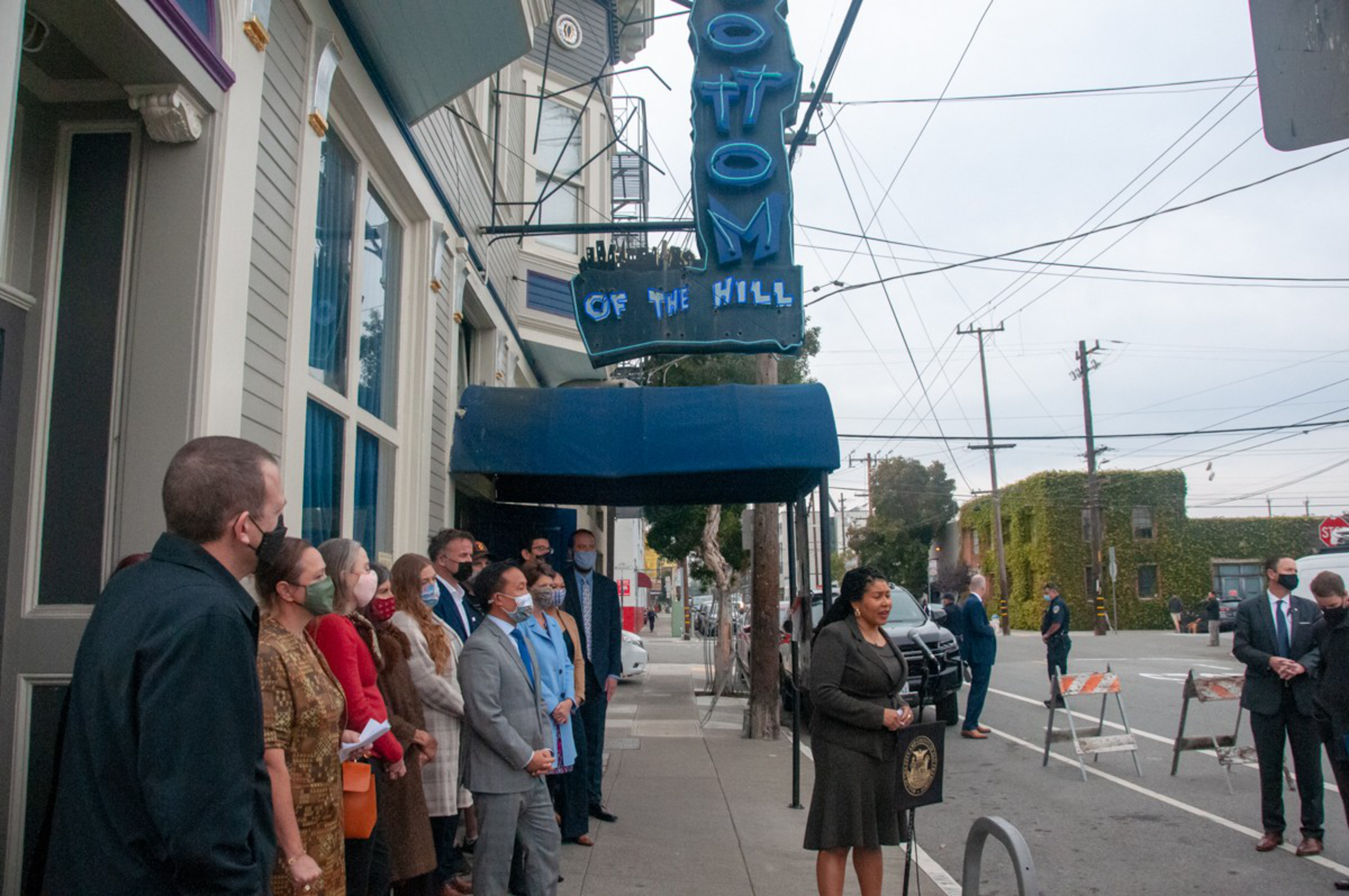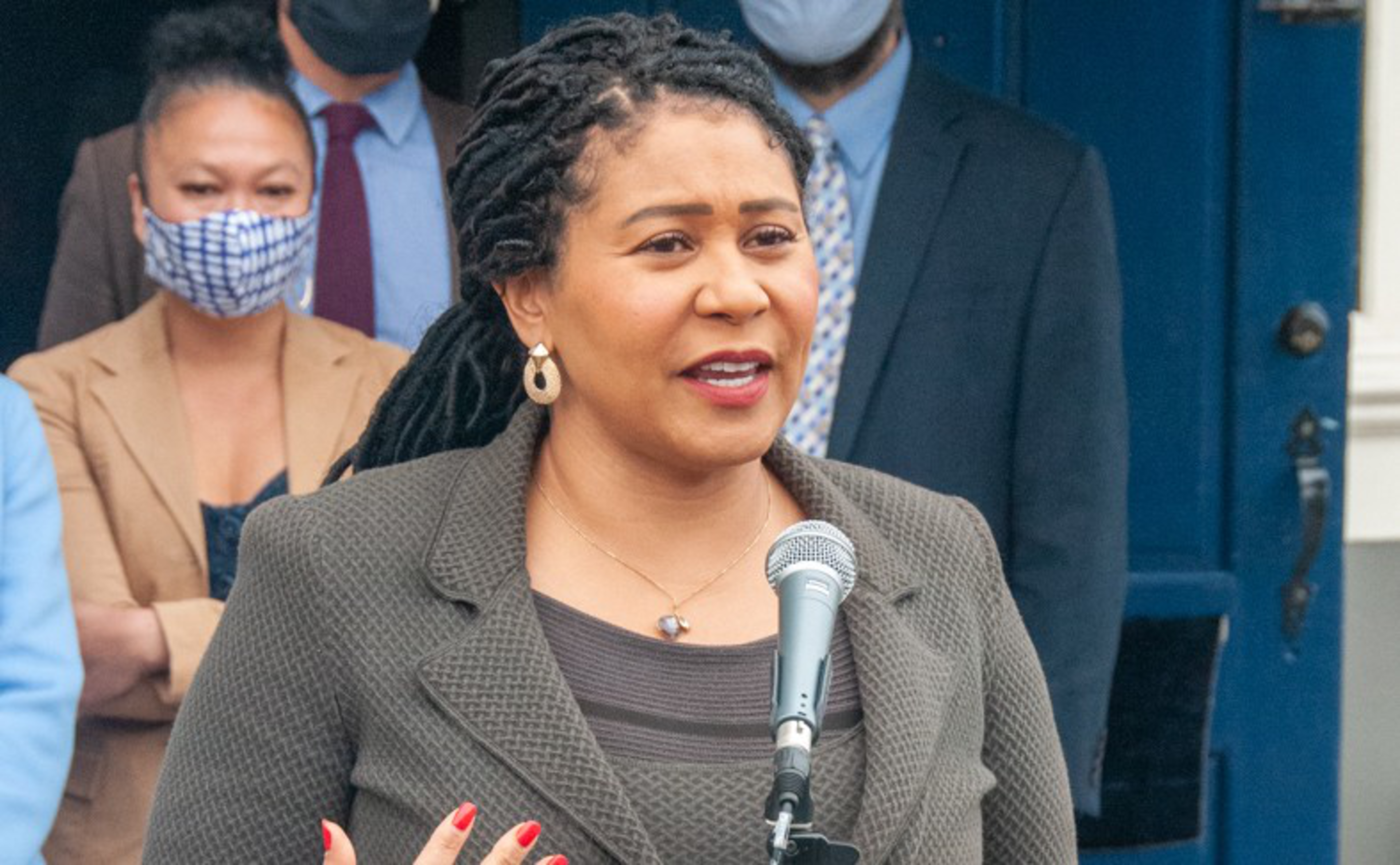For 17 long months, the owners of Bottom of the Hill weathered the storm. The live music venue, which marked 30 years in business in September (opens in new tab), had become accustomed to its underdog status. Working on a shoestring budget and fending off noise complaints from miffed neighbors has always gone hand-in-hand with running a tiny, tastemaking club far off the beaten path.
But the pandemic presented a truly novel and existential threat. “That was the first time we ever considered the possibility that we might not open again,” Lynn Schwartz said Monday morning, addressing a scrum of reporters out front of the venue she co-owns at the corner of 17th and Missouri streets in Potrero Hill.
That Bottom of the Hill continues to host loud bands and serve cheap beer nearly two years after San Francisco first shut down to slow the spread of COVID-19 is a testament to Schwartz’s grit and punk rock spirit, to be sure. But there’s more at stake than the fate of a favorite club: City officials see entertainment as a key driver of the local economy—a reason for people to pull themselves away from their Netflix queues, put on a pair of real pants, sit down for a meal, order a drink and tip their bartender.
Some politicians even reason that live entertainment might draw tech workers back to their long-abandoned sit-stand desks. On the flip side, many are worried that the tech industry’s broad acceptance of work-from-home will inevitably mean fewer people in San Francisco looking for a night out.
Schwartz, flanked by her business partners, Mayor London Breed and the newly minted City Attorney David Chiu, had convened the press conference to announce the roll out of the SF Live Initiative, which will funnel $2.5 million into the city’s live entertainment sector in 2022. The money is intended to produce a series of outdoor events curated by and benefiting local venues.
Even as the city eased restrictions on public gatherings in April—allowing live performances spaces to host indoor concerts at reduced capacity—smaller clubs like Bottom of the Hill remained closed (opens in new tab), as opening to a limited number of attendees would have only driven them further into the red.
Bottom of the Hill has been open for three months now. However, according to Schwartz, attendance is still not back up to what it was pre-pandemic—even for shows that are technically sold out, which she attributes to lingering fears over the virus.

“For every sell-out show that we’ve had, we’ve had about a third of the people not show up,” she says. “It’s not great for the venue. We get a small percentage of the door, but we make most of our money from bar sales.”
Breed, who kicked off Monday’s press conference, said the idea behind SF Live is to help reinvigorate and reactivate San Francisco through the arts—and to recognize the vital role clubs like Bottom of the Hill play in both the local economy and the cultural fabric of the city.
Taking in live music and dancing along to the beat—”there’s something about that that makes you smile,” she added.
Chiu, who helped secure the $2.5 million allocation for SF Live when he was still serving as a state assemblymember, recounted his own love of live performance as he addressed the television cameras and reporters gathered outside the club. “It is part of what makes our city great,” he said.
Chiu’s was a sentiment echoed by Kate Sofis, the former CEO and co-founder of SF Made, whom Breed chose earlier this year to lead the San Francisco Office of Economic and Workforce Development.
From Bill Graham’s heady days booking The Fillmore and Winterland Ballroom to the role that sweaty clubs like Mabuhay Gardens and Pound SF played in nurturing the city’s punk and metal scene, San Francisco’s “cherished venues” serve as a kind of magnet, Sofis said.
“At the highest level of economic recovery, this is also, I believe, the way that we get our city back,” Sofis continued. “I fully believe that our arts and music and cultural assets need to lead the economic recovery, front and center. They are the reason people move here.”
Sofis’ assertion that the performing arts will drive the city’s economic recovery is far from settled fact, however. A recent report by the New York Times (opens in new tab) directly addressed the question of whether the highly permissive work from home policies of San Francisco- and Silicon Valley-based tech companies would ultimately hurt the box offices of all city venues—from Davies Symphony Hall all the way down to The Bottom of the Hill.
For her part, Schwartz said she understands why people would decide to opt out of going to a show at a small venue like hers. She knows the chances of getting seriously ill at a show where all attendees are required to show proof of vaccination and follow San Francisco’s indoor masking rules are very slim. And yet there are days when even she gets nervous about being inside the club.
“We’re doing our best with safety measures, and we take it very seriously,” she said before trailing off. “But…”
